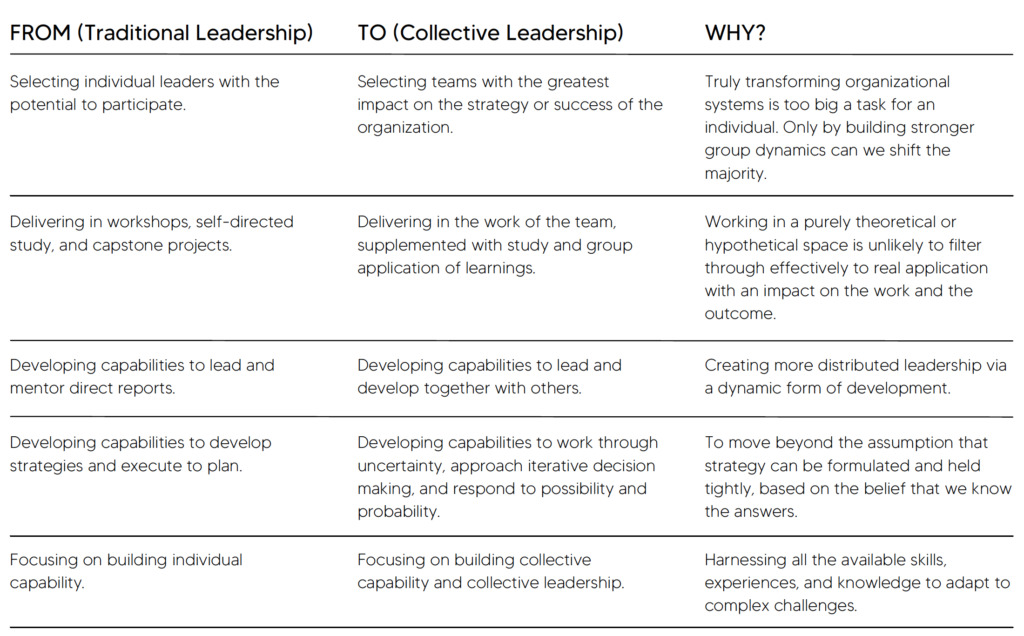Developing Leaders for an Unknown Future
Humans strive for homeostasis. Meaning, we instinctively want things to return to “normal.” So, with the constant change, debilitating uncertainty, and devastating impact on our best-laid plans, the last two years took us further out of our comfort zone than we’ve ever been. As we emerge into a new and uncertain world, we need new and adaptive ways of thinking and leading. To successfully navigate the future, we can never return to our old ideas of leadership and development.
I believe the last two years were the ultimate case study in why we need to transform our approach to leadership. They highlighted the need to navigate the unknown through collective leadership, where no individual has all the answers and the challenge at hand is a moving target.
Leadership Development for Then
Even in those dim and distant years before 2020, traditional models of leadership development had begun to flounder. For decades now, organizations have embraced flatter, more dynamic structures and agile, cross-functional methodologies for rolling out flexible, adaptive programs of work. Businesses redefine their business models frequently. New products and solutions are designed based on emerging data and customer feedback.
In such a dynamic world, we need entirely different skills and abilities. What we don’t need is a years-long development program that focuses on preparing people for the next step up on the ladder, and then the next. In this outdated model, potential leaders are selected from high performers across the business and then supported through stepped, sequential development programs to acquire capabilities around strategy, coaching, and mentorship – all with the aim of performing against an agreed plan.
Let’s face it, we’ve seen enough highly successful 20-something tech CEOs to know that decades of experience and years of training aren’t a prerequisite for great leadership these days. In today’s ever-changing world, what happens if the plan changes and you need to rapidly acquire skills that aren’t in your development roadmap until next year?
Today’s leaders need the ability to flex and adapt rapidly to respond to our unpredictable and volatile world. The way to do this is through collective leadership and our leadership development programs have some catching up to do.
Leadership Development for Now
So, how should we be thinking about leadership development today? Here are some key principles:
- Leadership development should support leaders to work as a team to harness collective perspectives, experiences, capabilities, and skills to respond to volatility and complexity. Today’s leaders need to learn to be responsive, adaptive, and collaborative.
- Leadership development should encourage a shift from the idea of individuals leading teams, to teams leading teams. Collective leadership is about embracing the idea of the leader as a host, rather than the leader as a hero[1]. Hosts promote shared learning, effective group decision making, reflection, visioning, and goal setting as well as mutual accountability.
- Leadership development should cultivate a humble approach, where the starting point is not knowing how to navigate the unknown. In collective leadership, we build practices to cultivate knowledge and apply skills “on the fly,” as we adapt and respond to new information or intelligence.
- Leadership development should encompass how to “hold the space” to evolve the plan and strategy on the go, mobilizing people when there isn’t a clear answer, direction, or even an obvious next step.
- Leadership development is about building a hyper-awareness of self – if you, as a leader, are not continuously adapting and growing, there’s a danger that the collective team loses its adaptability and begins to stagnate.
- Leadership development is about continuously building new skills, such as adaptability, taking different perspectives, exploring optionality and possibility, working flexibility, and delivering incrementally (to name just a few!).
- Leadership development is about praxis – taking the theory behind best practice change, transformation, and adaptive collective leadership, and applying it every day to build your practical skills.
- Leadership development doesn’t happen at a retreat, it happens in the work of the team. It’s about continually building new skills and applying them to real-time challenges. This enables the team to build the muscle memory and skill to adapt and respond, collectively navigating through whatever is coming next.
Getting Started with Collective Leadership Development
At the Karuna Collective, we focus on executive team coaching to develop collective leadership. Taking a leader away from the team for leadership development is pointless if you then bring them back to a stagnant team system where they can’t apply what they’ve learned. The magic lies in collective leadership – the collective’s ability to achieve what one person simply never could alone.
So, how to think about evolving your leadership development programs? The table below is a thought-starter.

At the Karuna Collective, we work with our clients to redesign old ways of thinking, operating, and leading organizations. We provide executive team coaching, team coaching, and collective leadership development. Contact us to find out how we can help you navigate complexity using collective leadership.
To learn more about Karuna Collective, please click here.





